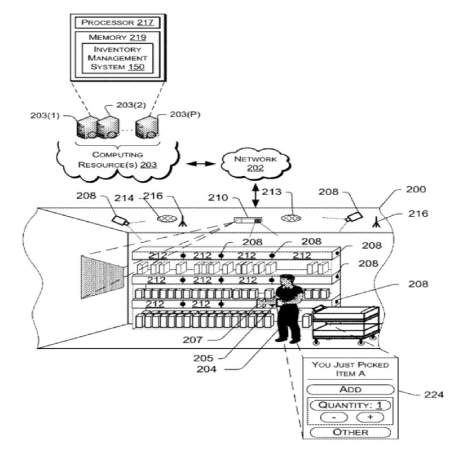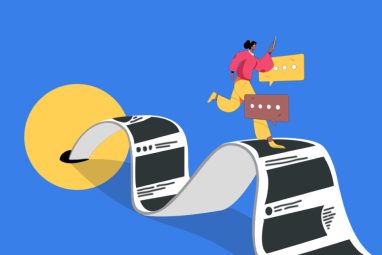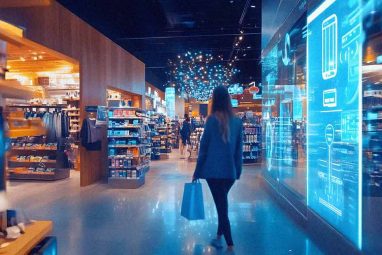Grab-And-Go CX Is The Future
Retail stores sit at the intersection of deep tech to cater to the needs of future customers. Who likes queuing? For customers, waiting is a waste of time. They want to walk into a supermarket, take something off of a shelf and leave without waiting at the checkout. Around 90 per cent of individuals used […]
Topics
What to Read Next
- Zeta Global, OpenAI Partner to Deliver Answer-Driven Marketing with Athena
- WPP Launches Agent Hub on WPP Open
- Stagwell Launches ‘The Machine’: Agentic Marketing Operating System
- PubMatic Unveils AgenticOS, the Operating System for Agent-to-Agent Advertising
- Marketing Architects, Jounce Media Partner to Bring CTV Buying Transparency

Retail stores sit at the intersection of deep tech to cater to the needs of future customers.
Who likes queuing? For customers, waiting is a waste of time. They want to walk into a supermarket, take something off of a shelf and leave without waiting at the checkout. Around 90 per cent of individuals used unattended retail as much or more during the pandemic as per a survey by Cantaloupe.
In 2016, Amazon announced the pilot version of a contactless retail store, probably the first. Come 2018, Amazon Go Store went live for the public — customers enter the place, grab products, and walk out. Introducing its shopping technology, Amazon announced how its retail tech offering, Just Walk Out Technology, works at the intersection of computer vision, sensor fusion, and deep learning algorithms. Overall, it is a combination of:
- 1-click-like Web shopping in retail
- A powerful app using location-based services
- QR Code IDs
- Integrated payment
- Image recognition
- Multiple sensor technologies
- Artificial intelligence
- Machine learning
Decoding the tech behind
It’s time to understand the tech in detail while walking through an imaginary retail store.
Check-In: Be ready with a smartphone and the application installed to enter the store by showing a barcode to a sensor. This barcode scan (together with additional sensor technology like GPS) tracks when a customer enters the store, when they move through the store and when they pick up a product.
Uninterrupted and hassle-free shopping: As the customer enters, every move is tracked and observed via sensor fusion, which lies at the trisection of lidars, radars, and cameras. The technology can combine inputs from many radars, lidars, and cameras to generate a single model or a complete image of the environment, similar to what it does around a vehicle. To be specific, radars have long-range sensing and detect object movement; lidars help in precise 3D object detection with accuracy; cameras provide scene context, help in object classification, and provide angular object position.
In April, a patent by Amazon Technologies for transitioning items from a materials handling facility (for example, a retail store) says the first data collected by input devices include at least one image of the first item captured by a camera when the first item is picked. An RFID tag identifier is detected by an RFID reader when the first item is selected or weight data measured when the first item is chosen.

Source: Amazon Patent
Automatic updation: When it comes to detecting item interaction and movement, a change in the number of items stored at the inventory location is detected based at least in part on information received from an input device located at the inventory location. The input device is at least a pressure sensor, a camera, an infrared sensor, a scale, a volume displacement sensor, or a light curtain, as per another patent filed by Amazon Technologies.
Check-Out: The 1-Click ordering button concept allows customers to enter their billing, shipping, and payment information once and then just click a button to purchase something in the future. The idea is to grab whatever one wants, toss it in a bag of choice, and leave without ever manually scanning items or interacting with a cashier.
After the cashier-less Amazon Go store launch, AiFi startup stated that it would supply a solution similar to Amazon Go’s Just Walk Out feature. According to AiFi, its system can track up to 500 people and tens of thousands of SKU (stock-keeping unit) item numbers in tens of thousands of square feet. The AiFi system was a subscription service to small businesses and big chain retailers. The end goal of the Grab and Go technology is to disrupt the retail sector and provide an all-new experience for customers, but how?
The impact
Thanks to technology, the equation has switched from the smartphone to the smart store. It has taken the retail shopping experience to a new level, altering the fabric of almost every retail buying experience over time and help even retailers apply the best possible strategies for customer experience.
Enhance CX with speed: Customers now expect the same level of speed and ease in person as they do online. Also, the expectation is to have more space and less physical interaction in stores due to the pandemic, which forced social distance. Hence, customers will be more loyal to stores that can provide such an experience. This will allow offline retailers to be more competitive with online merchants and give them an edge over physical retail competitors who can’t match the speed and convenience.
Personalising CX: Digitising stores helps catch granular data about customers’ preferences and behaviour, thereby enabling personalised recommendations for the customers. Furthermore, physical stores may affect what customers do in stores, from their paths to what they pick up and put down. They can even understand how long a customer pauses while deciding between two options. The data thus collected will help retailers optimise their pricing, inventory management, and physical product positioning.
Amazon Go wasn’t the only business attempting to eliminate the checkout line. Scan and Go technology was being rolled out in hundreds of stores by Walmart and Kroger, while Apple allowed customers to scan a barcode with a smartphone app before leaving the store for several years.
However, it’s important to take off the rose-tinted glasses, as it is problematic to consider frictionless stores as something without any pitfalls. Consumers will be concerned about what data is collected, how shops track them, or what happens if a data breach occurs. For companies, proper mechanisms must be put in place well in advance.
If you liked reading this, you might like our other stories
Get Your Data Machine Learning Ready
The Role Of Speech Tech In The Metaverse









































































































